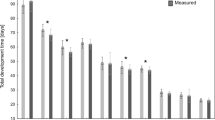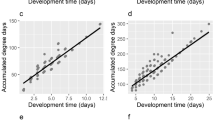Abstract
Some beetles are as useful as blow flies for estimating the minimum post mortem interval (PMImin) or time since death. Examples include Thanatophilus micans (Fabricius) and Thanatophilus mutilatus (Castelneau), two geographically and ecologically overlapping African beetles. Molecular means of identifying these species, descriptions of their natural history, thermal summation models for the development of each species, and a case in which T. micans was recovered are presented. These beetles colonise bodies soon after death, their development spans more time than that of flies, and they may be little affected by maggot-generated heat. From an experimental perspective, they can be reared individually, which allows the identification of sick individuals and has analytical advantages relative to fly larvae that must be reared in groups. Estimating minimum post mortem intervals for both species using the case data strongly suggests that developmental models parameterised for one species should not be used to make forensic estimates for closely related species for which no specific model is available and emphasises the need for correct identifications.








Similar content being viewed by others
References
Villet M, Richards C, Midgley J (2010) Contemporary precision, bias and accuracy of minimum post-mortem intervals estimated using development of carrion-feeding insects. In: Amendt J, Goff M, Campobasso C, Grassberger M (eds) Current concepts in forensic entomology. Springer Netherlands, Dordrecht, pp 109–137
Villet M, Amendt J (2011) Advances in entomological methods for death time estimation. In: Turk E (ed) Forensic pathology reviews. Humana Press, Heidelberg, pp 213–238
Hobischak N, Vanlaerhoven S, Anderson G (2006) Successional patterns of diversity in insect fauna on carrion in sun and shade in the boreal forest region of Canada, near Edmonton, Alberta. Can Entomol 138:376–383
Sharanowski B, Walker E, Anderson G (2008) Insect succession and decomposition patterns on shaded and sunlit carrion in Saskatchewan in three different seasons. Forensic Sci Int 179:219–240
Michaud J, Moreau G (2009) Predicting the visitation of carcasses by carrion-related insects under different rates of degree-day accumulation. Forensic Sci Int 185:78–83
Voss S, Spafford H, Dadour J (2009) Annual and seasonal patterns of insect succession on decomposing remains at two locations in Western Australia. Forensic Sci Int 193:26–36
Voss S, Cook D, Dadour I (2011) Decomposition and insect succession of clothed and unclothed carcasses in Western Australia. Forensic Sci Int 211:67–75
Matuszewski S, Bajerlein D, Konwerski S, Szpila K (2011) Insect succession and carrion decomposition in selected forests of Central Europe. part 3: succession of carrion fauna. Forensic Sci Int 207:150–163
Midgley J, Richards C, Villet M (2010) The utility of Coleoptera in forensic investigations. In: Amendt J, Goff M, Campobasso C, Grassberger M (eds) Current concepts in forensic entomology. Springer Netherlands, Dordrecht, pp 57–68
Villet M (2011) African carrion ecosystems and their insect communities in relation to forensic entomology. Pest Tech 5:1–15
Velásquez Y, Viloria AL (2009) Effects of temperature on the development of the Neotropical carrion beetle Oxelytrum discicolle (Brullé, 1840) (Coleoptera: Silphidae). Forensic Sci Int 185:107–109
Midgley J, Villet M (2009) Development of Thanatophilus micans (Fabricius 1794)(Coleoptera: Silphidae) at constant temperatures. Int J Legal Med 123:285–292
Schawaller W (1981) Taxonomie und Faunistik der Gattung Thanatophilus (Coleoptera: Silphidae). Stuttgarter Beitr Naturkd Ser A 351:1–21
Van Wielink P (2004) Kadavers in de kaaistoep: de natuurlijke successie van kevers en andere insecten in een vos en een ree. Entomol Ber 64:34–50
Adair T, Kondratieff B (2006) Three species of insects collected from an adult human corpse above 3300 m in elevation: a review of a case from Colorado. J Forensic Sci 51:1164–1165
Kelly J, Vander Linde T, Anderson G (2008) The influence of clothing and wrapping on carcass decomposition and arthropod succession: a winter study in central South Africa. Can Soc Forensic Sci J 41:135–147
Kelly J, van der Linde T, Anderson G (2009) The influence of clothing and wrapping on carcass decomposition and arthropod succession during the warmer seasons in central South Africa. J Forensic Sci 54:1105–1112
Von Lengerken H (1937) Studien über die Lebenserscheinungen der Silphini (Coleopt.) xi—xiii. Thanatophilus sinuatus F., rugosus L. und dispar Hrbst. Zoomorphology 33:654–666
Schawaller W (1987) Faunistische und systematische daten zur silphidae-fauna sudafrikas (Coleoptera, Silphidae). Z Entomol 19:277–285
Prins A (1984) Morphological and biological notes on some South African arthropods associated with decaying organic matter. Part 2: The predatory families Carabidae, Hydrophilidae, Histeridae, Staphylinidae and Silphidae (Coleoptera). Ann S Afr Mus 92:295–356
Simon C, Frati F, Beckenbach A, Crespi B, Liu H, Flook P (1994) Evolution, weighting, and phylogenetic utility of mitochondrial gene sequences and a compilation of conserved polymerase chain reaction primers. Ann entomol Soc Am 87:651–701
Thompson J, Gibson T, Plewniak F, Jeanmougin F, Higgins D (1997) The CLUSTAL_X windows interface: flexible strategies for multiple sequence alignment aided by quality analysis tools. Nucleic Acids Res 25:4876–4882
Ratcliffe B (1972) The natural history of Necrodes surinamensis (Fabr.) (Coleoptera: Silphidae). Transactions of the American Entomological Society 98:359–410
Richards C, Rowlinson C, Cuttiford L, Grimsley R, Hall M (2013) Decomposed liver has a significantly adverse affect [sic] on the development rate of the blowfly Calliphora vicina. Int J Legal Med 127:259–262
Day D, Wallman J (2006) Influence of substrate tissue type on larval growth in Calliphora augur and Lucilia cuprina (Diptera: Calliphoridae). J Forensic Sci 51:657–663
Clark K, Evans L, Wall R (2006) Growth rates of the blowfly, Lucilia sericata, on different body tissues. Forensic Sci Int 156:145–149
Richards CS, Paterson ID, Villet MH (2008) Estimating the age of immature Chrysomya albiceps (Diptera: Calliphoridae), correcting for temperature and geographical latitude. Int J Legal Med 122:271–279
Richards C, Villet M (2009) Data quality in thermal summation models of development of forensically important blowflies (Diptera: Calliphoridae): a case study. Med Vet Entomol 23:269–276
Villet MH (2007) An inexpensive geometrical micrometer for measuring small, live insects quickly without harming them. Entomol Exp Appl 122:279–280
Ikemoto T, Takai K (2000) A new linearized formula for the law of total effective temperature and the evaluation of line-fitting methods with both variables subject to error. Ecol Entomol 29:671–682
Higley L, Haskell N (2010) Insect development and forensic entomology. In: Byrd J, Castner J (eds) Forensic entomology: the utility of arthropods in legal investigations. CRC Press, London, pp 389–405
Core Team R (2012) R: a language and environment for statistical computing. Austria, Vienna
Richards C, Crous K, Villet M (2009) Models of development for the blow fly sister species Chrysomya chloropyga and C. putoria. Med Vet Entomol 23:56–61
Richards M, Price CS, Villet BW (2009) Thermal ecophysiology of seven carrion-feeding blowflies in Southern Africa. Entomol Exp Appl 131:11–19
Dourel L, Pasquerault T, Gaudry E, Vincent B (2010) Using estimated on-site ambient temperature has uncertain benefit when estimating postmortem interval. Psyche 610639:1–7
Baumjohann K, Schiwy-Bochat K, Rothschild M (2011) Maggots reveal a case of antemortal insect infestation. Int J Legal Med 125:487–492
Harvey M, Gaudieri S, Villet M, Dadour I (2008) A global study of forensically significant calliphorids: implications for identification. Forensic Sci Int 177:66–76
Meiklejohn K, Wallman J, Dowton M (2011) DNA-based identification of forensically important Australian Sarcophagidae (Diptera). Int J Legal Med 125:27–32
Noriega FG, Wells MA (1993) A comparison of three methods for isolation of RNA from mosquitoes. Insect Mol Biol 2:21–24
Ratcliffe B, Leudtke R (1969) A comparison of silphids taken from covered and uncovered carrion (Coleoptera: Silphidae). Coleopt Bull 23:103–105
Velásquez Y, Viloria Á (2010) Instar determination of the neotropical beetle Oxelytrum discicolle (Coleoptera: Silphidae). J Med Entomol 47:723–726
Midgley JM (2007) Aspects of the thermal ecology of six species of carcass beetles in South Africa, MSc Thesis, Rhodes University, p 68
Nuorteva P (1959) Studies on the significance of flies in the transmission of poliomyelitis. iii. The composition of the blow fly fauna and the activity of the flies in relation to the weather during the epidemic season of poliomyelitis in south Finland. Ann Entomol Fenn 25:121–136
Nuorteva P (1977) Sarcosaprophagous insects as forensic indicators. In: Tedeschi C, Eckert W, Tedeschi L (eds) Forensic medicine: a study in trauma and environmental hazards. WB Saunders, Philadelphia, pp 1072–1095
Greenberg B (1985) Distribution and medical ecology of the blow flies (Diptera: Calliphoridae) of Peru. Ann entomol Soc Am 78:565–587
Greenberg B (1990) Nocturnal oviposition behaviour of blow flies (Diptera: Calliphoridae). J Med Entomol 27:807–810
Singh D, Bharti M (2001) Further observations on the nocturnal oviposition behaviour of blow flies (Diptera: Caliphoridae). Forensic Sci Int 120:124–126
Amendt J, Zehner R, Reckel F (2008) The nocturnal oviposition behaviour of blowflies (Diptera: Calliphoridae) in central Europe and its forensic implications. Forensic Sci Int 175:61–64
Baqué M, Amendt J (2013) Strengthen forensic entomology in court—the need for data exploration and the validation of a generalised additive mixed model. Int J Legal Med 127:213–223
Villet MH, MacKenzie B, Muller WJ (2006) Larval development of the carrion-breeding flesh fly Sarcophaga (Liosarcophaga) tibialis Macquart (Diptera: Sarcophagidae) at constant temperatures. Afr Entomol 14:357–366
Grassberger M, Reiter C (2001) Effect of temperature on Lucilia sericata (Diptera: Calliphoridae) development with special reference to the isomegalen- and isomorphen-diagram. Forensic Sci Int 120:32–36
Coombs W (1979) The effect of temperature and humidity upon the development and fecundity of Dermestes haemorrhoidalis Küster and Dermestes peruvianus Laporte de Castelnau (Coleoptera: Dermestidae). J Stored Products Res 15:43–52
Louw G, Seely M (1982) Ecology of desert organisms. Longman Press, London, p 194
Acknowledgments
We thank Alicia Timm (Rhodes University) for access to laboratory facilities; Julia Joos Vandewalle for invaluable assistance in the laboratory; our three reviewers for their valuable comments and time; the South African Police Service for permission to work on the case; and Rhodes University for funding the project.
Author information
Authors and Affiliations
Corresponding authors
Rights and permissions
About this article
Cite this article
Ridgeway, J.A., Midgley, J.M., Collett, I.J. et al. Advantages of using development models of the carrion beetles Thanatophilus micans (Fabricius) and T. mutilatus (Castelneau) (Coleoptera: Silphidae) for estimating minimum post mortem intervals, verified with case data. Int J Legal Med 128, 207–220 (2014). https://doi.org/10.1007/s00414-013-0865-0
Received:
Accepted:
Published:
Issue Date:
DOI: https://doi.org/10.1007/s00414-013-0865-0




